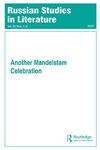谁是“统一的头脑”,为什么?(俄文布里亚特回指诗)
4区 文学
Q4 Arts and Humanities
引用次数: 0
摘要
尤里·奥利茨基概述了俄语诗歌翻译中回指线的出现(典型的传统布里亚特和蒙古诗歌)。从那时起,布里亚特的俄语诗人开始使用回指线;奥尔利茨基观察了其中三位,阿列克谢·乌拉诺夫和两位年轻的诗人拜尔·杜加罗夫和阿马萨娜·乌日塔耶夫。这篇文章包括了许多精彩的诗歌技巧的例子。本文章由计算机程序翻译,如有差异,请以英文原文为准。
Who Is “Unifying Heads” and Why? (Buryat Anaphoric Poetry in Russian)
Iurii Orlitskii outlines the emergence of anaphoric lines (typical of traditional Buryat and Mongolian poetry) in translations of that poetry in Russian. From there anaphoric lines have been taken up by Buryat poets writing in Russian; Orlitskii looks at three of them, Aleksei Ulanov and two younger poets, Bair Dugarov and Amarsana Ulzytaev. The article includes a number of wonderful poetic examples of the technique.
求助全文
通过发布文献求助,成功后即可免费获取论文全文。
去求助
来源期刊

RUSSIAN STUDIES IN LITERATURE
LITERATURE, SLAVIC-
自引率
0.00%
发文量
0
期刊介绍:
Russian Studies in Literature publishes high-quality, annotated translations of Russian literary criticism and scholarship on contemporary works and popular cultural topics as well as the classics. Selections are drawn from the leading literary periodicals including Literaturnaia gazeta (Literary Gazette), Novoe literaturnoe obozrenie (New Literary Review), Oktiabr (October), Voprosy literatury (Problems of Literature), and Znamia (Banner). An editorial introduction to every issue provides context and insight that will be helpful for English-language readers.
 求助内容:
求助内容: 应助结果提醒方式:
应助结果提醒方式:


